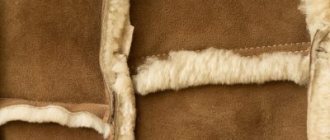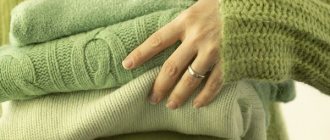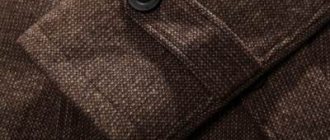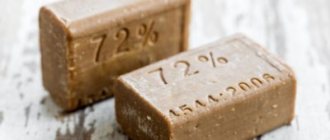Woolen items are loved by many. Items made from natural or mixed wool can definitely be found in every wardrobe. They are loved for the beauty and comfort they give. But not everyone knows how to wash woolen items so that they do not lose their appearance and shape. Hence there is a whole heap of damaged clothes in almost every home. Something has stretched out, something has hopelessly collapsed... Such troubles can be avoided. The main thing is to know how to approach the wool.
What not to do when washing wool products
When starting this difficult task, you should study the most common mistakes, avoiding which it will not be so difficult to care for cashmere or mohair:
- Frequent washing. This is a natural material that is naturally dirt-resistant. It will be enough to wash it twice a year; for freshness, you can simply hang your favorite sweater on the balcony, and dry cleaning is often enough to remove stains.
- You should not soak sweaters and cardigans for a long time - this will lead to severe shrinkage; it is advisable that the whole process takes no more than 45 minutes.
- You cannot change the temperature suddenly. If wool is washed at 30 degrees, then it should be rinsed at approximately the same temperature.
- The material does not tolerate strong friction and squeezing. Therefore, when washing in a washing machine, this mode is turned off or, in extreme cases, set to minimum speed.
- Knitted clothes should not be dried on hangers or on a rope, otherwise they will stretch.
Processing time
The washing time when the “Wool” mode is selected differs depending on the brand and model of the washing machine. Its increase is affected by water temperature and spin speed. The higher these indicators, the longer things will stay in the drum.
What matters are the options that the user selects when setting up the program. For example, “Extra Rinse” may be set or the “Express Wash” function may be selected. On average, the entire process takes 45-55 minutes.
Although there are SMAs in which the washing time in the “Wool” mode is 1.5-2 hours. If possible, avoid leaving delicate fabrics in water for such long periods of time. Recommended washing time is 40 minutes .
The best option for woolen items
The best way to wash wool is by hand, since not even the most delicate machine mode will give such a result. The item, subjected to minimal mechanical damage, will not lose its appearance, quality and properties.
Hand washing rules:
- use specialized tools;
- the water should be at a temperature no higher than 35-40 degrees;
- the product must be rinsed well;
- When squeezing, such material is not twisted, you can simply squeeze it lightly to remove excess moisture;
- dry by laying it on a flat surface, you can lay a terry towel.
Step by step process:
- Before you start hand washing wool items, they should be cleaned in heavily soiled areas. Place in a container for 5 minutes to wet all the fibers evenly. In a cup, dilute the detergent with water at the same temperature and whip up the foam; when using powder, it is important that it dissolves completely. Having added the soap mixture, start washing, lightly pressing on the product; if there are stains, clean them with a soft brush.
- They also rinse with light pressure in a large volume of water and change it 3-4 times until the foam is completely washed away. They lift the clothes carefully, holding them from below so that they do not stretch; instead of squeezing them, they roll them up with a roller and lightly press them on top. For drying - spread on a horizontal surface in a well-ventilated room.
Important! Before this procedure, you need to check the fabric for color fastness; to do this, carefully pull the fiber out of the fabric and soak it at a temperature above 50 degrees. Then put it on a white napkin and blot it; if it is stained, then add vinegar to the solution at the rate of 5 liters, 2 tablespoons.
Water temperature
Wool, like any other natural material, requires a delicate approach. An important point when cleaning such things is water. It shouldn't be too cold or too hot. It is advisable to add a softening agent to it before starting so that it is not oversaturated with alkali and chlorine. The optimal temperature for wool clothing is 35 degrees.
Designations in SMA of different brands
Depending on the brand of the washing machine, the settings for the “Wool” mode will differ:
- Bosch . Default settings: spin – 800 rpm, duration – 40 minutes, water temperature – 40 degrees. Heating can be reduced to 30 degrees or turned off completely.
- . Default settings: spin – 800 rpm, water heating – up to 40 degrees. If necessary, all listed options can be reduced to zero. The average duration of the program is 1 hour.
- Samsung . The mode in the SMA data is literally called “Hand washing wool”. Default settings: water temperature – from 30 to 40 degrees, maximum spin speed – 800 rpm. The cycle lasts from 40 to 50 minutes. Maximum drum load is 2 kg.
- Indesit . Default settings: water heating – 40 degrees, spin speed – 800 rpm, cycle duration – 55 minutes.
- Candy . Default settings: water heating – 30 degrees, spin speed – 800 rpm. The cycle duration is half an hour.
How to wash wool items in a washing machine
If you don’t have time to wash by hand, you can do it in an automatic machine. But you need to look at the label to see if this option is allowed for a particular type of clothing. Before you load things into the drum, you need to:
- remove all accessories (clasps, buttons) to prevent damage;
- sew up the loops so that they do not stretch;
- turn a thing inside out;
- separate from other fabrics, divide into dark and light shades;
- When washing multi-colored clothes in one go, be sure to check them for color fastness.
Modern machines have a “wool” program, usually it is already configured in all respects, but if it is not there, you can use the “delicate” mode, but disabling the spin cycle. It is advisable to add a product without synthetic additives in liquid form or a fine-grained, highly soluble powder. After the end of the program, the items are carefully pulled out and excess moisture is removed from them.
Features of washing white woolen items
White clothes become yellowish over time. If ordinary fabrics can be soaked with bleach, then in the case of knitted fabrics this option will not work. You can restore color to white woolen items using several methods.
Soda
Baking soda or soda ash is suitable for severe yellowness. Carefully dilute 2 tablespoons in 10 liters of warm water, adding a couple of drops of ammonia, and pour the solution over pre-washed items. Then rinse well with plenty of water.
We recommend:
How to wash towels at home without boiling
Additional Information! Baking soda can be added with each wash to help maintain whiteness.
Chalk
Using chalk you can lightly whiten the product. For 500 grams of wool you will need one kilogram of chalk. It needs to be crushed into powder and diluted in three liters of water, put white things into the mixture and keep them for 10-12 hours. Stir occasionally, as the chalk does not dissolve and will settle to the bottom.
Hydrogen peroxide
A bleach proven over the years. It is diluted in the proportion of one part peroxide to eight parts cool water. Soaking lasts 4-6 hours, then rinse with the addition of conditioner, since the peroxide leaves a medicine smell.
Salt
A medium-strength saline solution will help maintain whiteness. To do this, sodium chlorine is dissolved in hot water and the woolen product is dipped into it several times. Rinse thoroughly to remove any remaining salt crystals. This procedure can be repeated periodically.
Note! You should make sure that dark ones are not lost among the light ones; even if they do not fade, lint may stick to the white, which will irrevocably ruin it.
How to wash wool - 5 general rules
As already mentioned, wool comes in different varieties. Therefore, when washing, it is correct to be guided by the information on the label of a particular item. Some products cannot be washed at all, and the only thing the manufacturer allows is dry cleaning (of course, not at home).
If for some reason there is no label with washing recommendations on a woolen item, you should follow the general rules:
- The wool is soaked for a maximum of half an hour.
- Use warm water for washing.
- Detergents are liquid (powdered ones must first be dissolved).
- Several rinses, in plenty of warm water.
- Woolen items are only lightly wrung out without twisting or the water is allowed to drain.
At what temperature should I wash wool?
In hot water, wool loses its strength and slowly disintegrates into fibers. Therefore, woolen products should be washed at a temperature of 30-38 degrees. This is quite enough for light stains to soften and easily come off the item. If washing is needed for refreshment, you can not heat the water at all, but use cold or room temperature water right away.
Wool is not afraid of cold water, unless it stays in it for a long time. So, when exposed 20 times for 24 hours, its slight hydrolysis (decomposition) begins. But in general, low temperatures can only be harmful if there are sudden changes. For example, if you washed a woolen sweater in hot water and rinsed it in cold water, then the product would shrink.
How to wash woolen items?
Regular washing powders are harmful to wool. They contain a lot of alkali, which can dissolve natural fiber without leaving any residue. If you leave a woolen item in a 5% solution of caustic soda, not a trace will remain of it. The fact is that wool is of animal origin and consists of 75-85% keratin protein. Alkali is designed to dissolve protein contaminants, so it spoils animal fibers. But at the same time, wool fabric is resistant to acids.
In industry, to remove plant debris (burdock, etc.) from wool, it is washed in a 5% solution of sulfuric acid. And to clean natural fabrics from cotton, linen and other plants from protein impurities, use a 5% solution of caustic soda.
A separate line of detergents is produced for washing wool products at home. They have the following notes:
- "phosphate-free"
- "for delicate things"
- "for products made of wool and silk."
We recommend: How to wash holofiber pillows using a washing machine and not spoil the products?
Special gels and powders are available from Perwoll, Royal Powder, Laska, Sonett, Frosch and others. As for folk remedies for washing wool, experienced housewives advise using:
- shampoo;
- liquid soap with the addition of 1 tbsp. l. borax (for 5-7 kg of woolen items);
- grated laundry soap;
- mustard powder (30 g per 2 liters of water).
To prevent the wool from pricking and matting, it is recommended to additionally use conditioner and rinse aid when washing. The purchased product can be replaced with a homemade composition. To do this, hair balm, vinegar and water are mixed in a ratio of 2:3:6. For 5 liters of water the consumption is approximately 120 ml. Alternative recipe: for 5 liters of water you need to take 5 tbsp. spoons of vinegar and 1 tbsp. a spoonful of glycerin.
Washing frequency
Wool does not like water and chemicals, so it is advisable to wash products made from it as rarely as possible. If the item is not critically dirty, it is recommended to use alternative cleaning methods:
- Unpleasant odor can be easily removed from wool by airing for 24-48 hours.
- Stains from food, drinks, and lipstick are wiped off with a damp cloth or alcohol solution.
- Greasy areas are cleaned with ammonia and a soft brush.
- Oil stains and paint marks are removed with turpentine or gasoline.
- To remove coffee, tea, and milk from wool, you can use glycerin slightly heated in a water bath.
Laundry powders
The capricious material, made from 100% fur, is capable of deformation from various external factors. For example, high temperature promotes shrinkage, and coarse powders destroy the structure of the thread. Therefore, the choice of product should be approached seriously and with caution. It is better to use special gels for woolen products; their production involves the exclusion or minimization of aggressive substances in the composition.
Modern industry offers mainly gels made from natural and eco-friendly ingredients to care for things made from this material. In addition to liquid ones, you can also find powdered products; unlike conventional powders, they do not contain large crystals.
Recommendations for using detergents:
- Direct contact of cleaning products with the fabric should be avoided; it should be diluted in advance in a small amount of water;
- Gels for wool are well suited, but if the choice is the dry option, let it be a special powder;
- if you urgently need to wash a woolen item, but you don’t have a solution for it on hand, you can use your own shampoo;
- in cases where the situation forces you to resort to regular washing powder, it must be thoroughly dissolved before placing the wool there.
Storage
Things knitted from wool are capricious, therefore:
- You cannot hang clothes on hangers, otherwise the fabric will be deformed and stretched;
- the same product should not be worn for several days in a row;
- remove pellets that appear on woolen fabric with a special machine;
- do not store clothes folded on top of knitted items in the closet;
- purchase an anti-moth product and put it in places where woolen products are stored.
By using simple instructions for caring and washing woolen items, you will ensure that your clothes will last longer with their softness, warmth and attractive appearance.
Secrets of experienced housewives
Since ancient times, women have figured out how to wash wool items using folk methods, without using powders and gels. There are three common and time-tested recipes:
- prepare a decoction from 1 kg of white beans in 5 liters of water, cool to 45 degrees and soak clothes - effective for minor stains;
- make a decoction of potatoes - suitable for washing blankets with serious types of stains;
- Grind the mustard powder under running water, strain and soak clothes in one half for 10 minutes, wash with your hands and rinse in the remaining solution.
Important! It is worth excluding the use of laundry soap, as it consists of fatty acids and a large amount of alkalis, which destroy natural fibers.
By adhering to the above rules and recommendations, even the most inexperienced housewife can handle caring for woolen items. If you still have doubts about your abilities, then you shouldn’t take risks, but it’s better to trust the professionals and take your clothes to the dry cleaner.
Rate this post
Useful tips
There are a number of recommendations obtained as a result of the life experience of housewives on how to properly care for woolen items so that they retain their original appearance for a long time. Here are some of them:
- Do not dry woolen items in or near the kitchen. They absorb odors well.
- Sweat and other unpleasant odors easily disappear from wool, so it is recommended to ventilate it as often as possible in the fresh air in the yard or by hanging it on the balcony.
- Do not use batteries or other heat sources for drying. In this case, the quality of the fabric may deteriorate greatly, and the item will become unpleasant to the touch.
- For long-term storage, it is recommended to use vacuum bags. They will protect the item from insects and help maintain its shape until the next use.
- In the closet where clothes made from natural fabrics are located, you need to put anti-moth products, since they love wool very much and will quickly ruin it.
- If the item is new and has a little dirt, then if possible it is better to have it dry cleaned. This way there is a greater chance that it will retain its shape, size and color.
- It is not recommended to use aggressive bleaches. They can thin the fibers and ruin the fabric.
Comment! Some types of woolen items are not ironed after drying. But there are those whose appearance requires ironing. To do this, turn the product inside out. You can use the steam iron setting or a damp cloth.











